Diseases and pests of peas
Tasty and sweet green peas are always a welcome guest on our table. However, the cultivation process of this crop may be aggravated by the appearance of various difficulties that can spoil the long-awaited fruits or even destroy them. To prevent damage to the future crop, it is enough to know in advance about the main parasites of peas and measures to combat them and follow the simple rules of growing a plant. In this article, we will consider how to process peas from pests and diseases, as well as the most dangerous and common ones.
Pea disease
Peas, like any other representative of legumes, are affected by all kinds of diseases that can significantly reduce the yield and worsen its presentation and taste. To reduce the risk of developing infections, preventive measures are required, which include competent selection of pea varieties, chemical treatment and compliance with planting and plant care standards. In addition, you must also have an idea about the protection of this culture from the most common diseases, as well as their characteristics. Consider the main ones.
Learn about the benefits and harms of peas.
Ascochitosis
One of the most dangerous fungal diseases, common in the main areas of pea cultivation, affects other legumes insignificantly. It is characterized by the defeat of all organs of the plant, which is why young seedlings die immediately, and in adults, the fruits thinning noticeably and become unusable. The disease manifests itself in the form of brown spots with small black dots in the center - "pycnidia".
These are disputes, their task is to provide a new infection that will occur after they mature and burst. The stains penetrate into the stems so deep that they form long ulcers. The seeds of the affected plants are wrinkled, covered with brown spots, non-viable. Ascochitosis develops due to increased environmental humidity and frequent precipitation, as well as excessive soil acidity. Sources of infection can be the remains of the affected seeds of the previous crop, in which the pathogen mycelium is located.

It is important to remember that resistant varieties of peas to this disease do not exist, therefore only preventive measures can prevent the development of infection. In case of damage to the plant by ascochitosis, it is necessary to spray copper sulfate at a concentration of 0.5%.
A good result will also be obtained by pre-soaking the seeds in a fungicide solution, which is carried out for 10 hours immediately before the day of sowing. At the advanced stage of the development of the disease, no treatment will help, and it is recommended that the affected plants be eliminated and burned.
Read also what you can plant after peas in the garden.
Anthracnose
Another fungal disease that is symptomatically similar to ascochitosis, but is much less common. Anthracnose is characterized by the appearance on all aerial parts of the plant of light gray spots with an orange center, in which spores of conidia - fungi are located. The culture attacked by the disease is not only characterized by reduced productivity, but also by significantly impaired seed germination and quality. Anthracnose affects a growing plant throughout the entire growing season, and the development of the disease at the stage of the appearance of beans is especially dangerous.

The main measure of combating anthracnose is the use of agrotechnical techniques - timely and high-quality soil cultivation, elimination of the remains of affected plants and maintaining crop rotation. As a preventive measure, seeds are also treated before planting, and various chemicals are used to treat diseased plants. An effective tool for eliminating anthracnose is Impact. Otherwise, measures to combat this disease do not differ from measures to combat ascochitosis.
Important! An effective measure against the spread of infection will be covering the pea plantings with a film.
Rust
An extremely dangerous ailment that occurs everywhere in all areas of cultivation of this crop, especially harms peas in the southern regions, since it acquires the most intensive development in a warm and very humid climate. The consequences of the disease are a violation of the biochemical processes of the plant and the loss of its viability, which later affects the course of photosynthesis.
The symptomatology of rust is pronounced: the so-called pustules appear on the stems and leaves of peas - a rash in the form of dark brown oval spots, which, as a rule, is placed concentrically. With increased infection, drying and premature falling of leaves are also noted, and beans at this advanced stage finally stop their development.

The main methods of protection against pea rust are as follows:
- sowing varieties resistant to the disease, including Stambovy 2, Capital, Harvest, Oilseed and others;
- the destruction of weeds nearby and directly on the territory of the growth of peas, especially the intermediate host of infection - milkweed;
- autumn plowing of the soil;
- early sowing;
- chemical control methods include timely treatment with fungicides, namely 1% Bordeaux liquid or special powder Tsineb, the consumption rate of which is 5–7 kg per 1 ha no later than a month before harvesting.
Did you know? For the first time in the countries of the New World, peas were introduced by Christopher Columbus in 1493, this happened on the island of Isabella.
Peronosporosis (downy mildew)
Peronosporosis, which is also called downy mildew, is not uncommon for pea plantings. Having a fungal nature, the disease affects mainly the aerial organs of the plant, and with intensive development, the beans, which are covered with gray powdery coating. The disease can manifest itself in several forms: local and diffuse.
The local form of the ailment is characterized by the appearance on the leaves of small roundish spots of yellow or brown shades, while on the underside a violet bloom forms on the underside — a sporulation characteristic of this kind of disease. Infected beans begin to discolor gradually to subsequently take on a dark brown color.

As preventive measures with an ailment, we can distinguish:
- the selection of varieties that are relatively stable and affected much less - Victoria Heine, Jubilee, Orlik and Pauli;
- selection of a sunny and well-blown plot for sowing;
- complete destruction of post-harvest residues and systematic weeding;
- spraying seeds with chemicals such as Fentyuram or TMTD, and if there are signs of peronosporosis, a one percent Bordeaux mixture or Tsineba powder, diluted in a ratio of 2-3 kg per 1 ha, is used.
Important! Among the folk remedies that eliminate insect pests include infusions of crushed leaves of burdock, tobacco, ash and celandine, which must be sprayed with damaged plants necessarily in the dark.
Fusarium
No less dangerous disease that develops rapidly and can lead to the death of plants during the entire growing season. Distributed mainly in climatic zones with unstable water regime of the soil and stable high air temperature. Fusarium infection is characterized by damage to the vascular system and plant tissues, which is why the disease is also called "fusarium wilt."
The external signs of the disease include a sharp yellowing and falling of leaves, rotting of the roots and the formation of a pinkish plaque at the basal neck. The stems of the affected plant quickly fade, lose their elasticity and shape, the top wilts, and the beans acquire a purple hue. Seeds are also susceptible to infection.
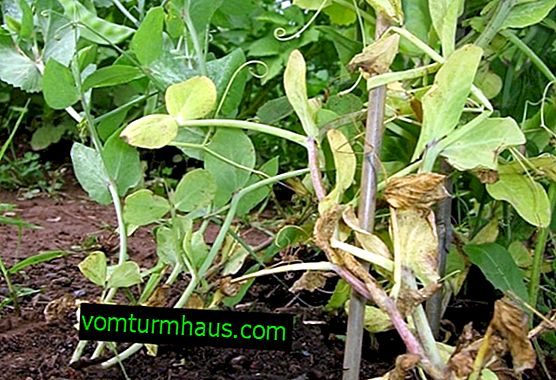
The infection can be transmitted through the seeds of the previous crop and plant debris, as well as after an inept alternation of different crops in one sowing area, the soil of which during this period has accumulated a sufficient amount of harmful spores.
An effective measure of protection against Fusarium infection can only be compliance with agricultural standards, namely:
- correct and competent change of cultures;
- timely disinfection of the soil and sterilization of working tools;
- crop rotation;
- preparation of seed material, which consists in processing combined chemical preparations, TMTD and Trichodermin are ideal . In case of infection in plants, antifungal agents such as Fundazole and Fludioxonil are used .
Did you know? Among legumes, peas lead in the amount of protein content, not much inferior only to lentils, which contain 7 g of protein per 100 g of product, and in peas - 5 g.
Root rot
Root rot is a particularly dangerous form of fusarium, especially for seedlings, since it affects the fragile tissues of the plant. The disease is widespread and capable of infection during all vegetative periods, most often the plant dies before it can produce beans. More stable varieties of the disease bring a strong developmental lag, as a result of which fairly tender and unpleasant in taste and color fruits are formed.
In diseased plants, there are brown spots on the stems, which subsequently turn into large ulcers with pinkish spores in the center, and the underground parts lose their turgor and rot after some time. Infected seeds and beans in particularly wet weather tend to be covered with a pinkish coating.

However, the disease can also be encountered in case of high humidity at the stage of seed maturation and even in storage. Spore infection occurs through soil in which plant debris and infected seeds are stored. To reduce the risk of developing adversity, you must adhere to the following recommendations:
- select resistant pea varieties of the disease: Uncovered 1, Nemchinovsky 776, Uladovsky 10 and others;
- to enhance the growth and development of plants, treat the soil with potash and phosphorus fertilizers;
- regularly clean the bed of weeds;
- during the entire growing season, spraying of crops with permissible fungicides is allowed.
Learn how to grow peas.
Pea pests
No less big trouble for those who want to grow peas are insect pests, which in large quantities are able to almost completely destroy the crop and its quality. Parasites are also dangerous during storage of beans of this culture.
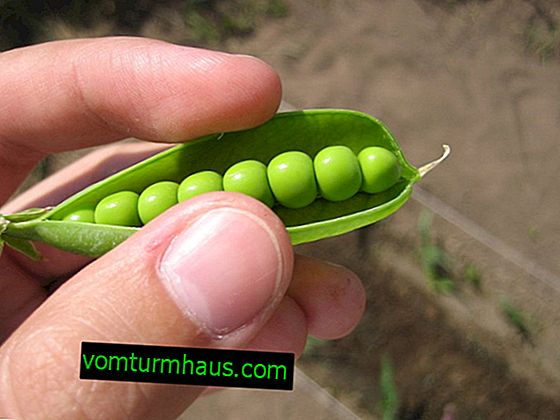
Pea moth
One of the most widespread and worst enemies of peas is the pea moth or, as it is also called, bruchus. The pest is a brown caterpillar with a length of 7–9 mm, which is most active in the dark during calm and arid weather, therefore, gardeners of the southern regions are most often faced with this scourge. Having laid its larvae on the leaves and flowers of peas, the parasite immediately prepares for wintering, so that next spring it will postpone a new clutch.
Hatched caterpillars penetrate the fetus and feed on a pea, leaving it after a few weeks. A sign of pea defeat by the moth is a gnawed hole on the pod, inside of which there are peas covered with a black spider web. Loss of yield after the life of the pest can reach about 40-50%. Seeds damaged by the moth produce weak and painful plants, which are subsequently attacked by other insects.

No less effective are decoctions of tomato tops and wormwood. As for chemical analogues, it is possible to spray the affected plants with Fastak, which is diluted in a proportion of 2 ml per 15 liters of water and consumed per liter per 15 square meters. m culture. Agrotechnical measures include:
- planting of early ripe pea varieties, the development of which is ahead of the activity of the parasite;
- early sowing;
- cleaning the site from the crop residues of the previous crop;
- the use of healthy and pre-processed seeds.
Grain
Zernovka is a small-sized beetle of the Bruchus genus, whose life span falls at the beginning of the fruiting of peas. The larva of the parasite pupates in the grains, and in autumn, adult individuals leave their shelter, wintering among plant debris and under the bark of trees. The pest itself is oval, black, with a cross-shaped pattern on the abdomen.
Grain refers to the barn pests of peas, which is distributed around the world along with the seeds of all legumes, but prefers to eat exclusively from this crop. A favorable condition for the development of the pest is sunny and humid weather, which, with its duration in the future, will only increase the number of the parasite.
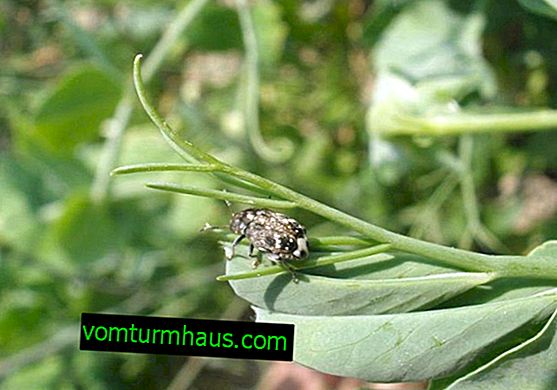
The main measure of protection is the use of chemicals - insecticides, which process crops at the beginning of flowering, as well as the storage of grain at low temperatures. Agrotechnical methods of struggle:
- early sowing of culture;
- deep autumnal plowing, which blocks the exit of beetles;
- destruction of plant debris;
- crop rotation compliance.
Nodule weevil
Another dangerous pest of peas, which inhibits its growth by damaging the roots of the plant. The weevil is characterized by wintering in the usual place of feeding, that is, in fields sown with legumes. The beetle is small in length, only 5 mm, gray, devoid of legs and eyes, and the chitinized head is equipped with dark mandibles.
From the very first days of life, the parasite needs additional nutrition, so its appearance on pea leaves can be noticed already in the first spring days. A pest is capable of destroying all foliage in just a day, even in the vast territory of culture growth, since beetles never leave their homes and do not stop even at night.
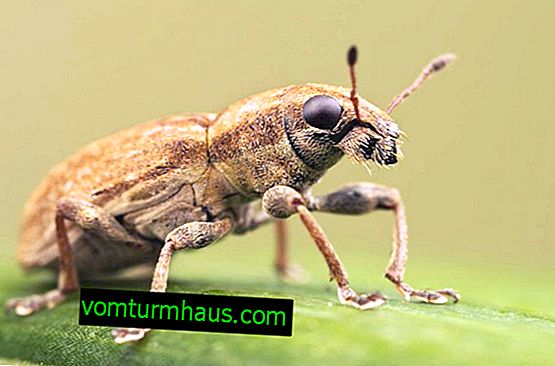
Сдерживают появление вредителей обычно природные условия — это могут быть как внезапные заморозки, так и продолжительная засушливая погода. Помимо этого фактора, полагаться на который неразумно, существует также ряд мероприятий, направленных на предупреждение напасти — это и агротехнические приёмы, и отпугивающие паразита химические вещества.
Хорошо проявил себя в качестве способа борьбы средство под названием Фастак, пропорции которого аналогичны пропорциям при борьбе с гороховой плодожоркой. Защита посевов от вредителя предполагает также тщательную вспашку земли после уборки прошлого урожая, известкование почвы и посев гороха подальше от остальных зернобобовых культур.
Бобовая огнёвка
Бобовая или акациевая огнёвка — один из самых злостных и беспощадных уничтожителей гороха во всех зонах его произрастания. Массовое размножение данного вредителя способно снизить урожай до 50%, чему в значительной мере способствует жаркая и засушливая погода, а повреждённые зёрна утрачивают свои посевные качества и становятся непригодными к использованию.
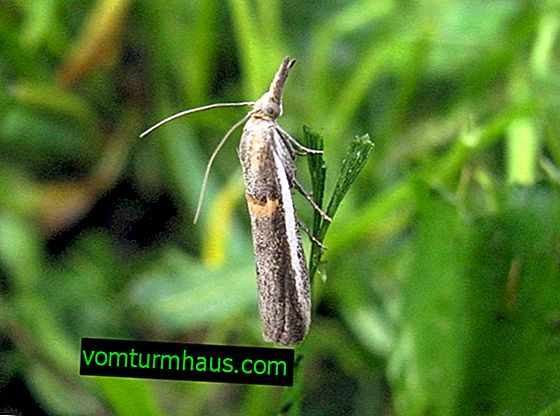
Самки осуществляют кладку яиц на завязи венчика либо на тычиночные трубочки, реже — на молодые плоды. Отродившиеся гусеницы разрушают створку боба и питаются его содержимым, а закончив, сразу же перемещаются на другой боб, при этом оставляя за собой паутинку экскрементов.
Не допустить к гороху паразита можно при помощи несложных агротехнических приёмов:
- вспашки почвы, которая обеспечивает глубокое запахивание гусениц;
- посеве культуры в оптимальные сроки;
- изоляции гороха от ближайших акациевых посадок;
- борьбе с сорняками.
К сожалению, химическая мера защиты ещё до конца не проверена и не изучена, однако наибольшую эффективность показали предварительные опрыскивания хлорофосом (2 кг на 1 га) и фосфамидом (2, 5 кг на 1 га).
Нутовая минирующая муха
Данный вредитель представляет опасность для множества зернобобовых культур, личинки которого прогрызают ходы во всех частях растений, а взрослые особи прокалывают стебли и кормятся растительными соками. В результате таких повреждений значительно снижается урожай — до 60–70%. Муха небольшой длины — всего 2 мм, коричневого цвета, с ярко-жёлтой головой и специальным хоботком, которым вредитель прокалывает растение для того, чтобы покормиться или отложить яйца.
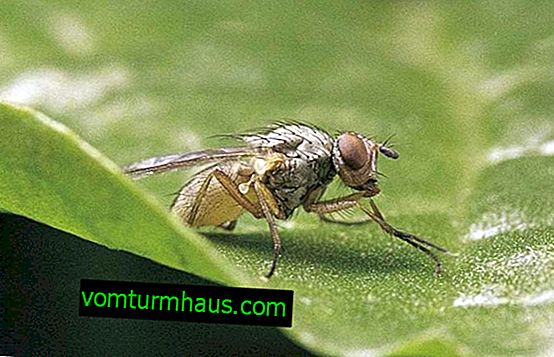
К мерам борьбы с вредителем относят глубокую вспашку земли, в которой зимуют куколки, и уничтожение близрастущих сорняков, которые также служат пищей для паразита. Из химических способов можно выделить различные инсектициды и препарат Веримек, который отличается способностью глубоко въедаться в листья и эффективно устранять и взрослых особей, и личинок.
Aphid
Самый распространённый вредитель всех сельскохозяйственных растений, который одновременно является и переносчиком различных вирусов. Вредоносность паразита заключается в высасывании сока из растения, покрывании его испражнениями, куда впоследствии попадают споры болезнетворных грибов. Даже при условии несильного поражения растения убытки урожая достигают 70%.
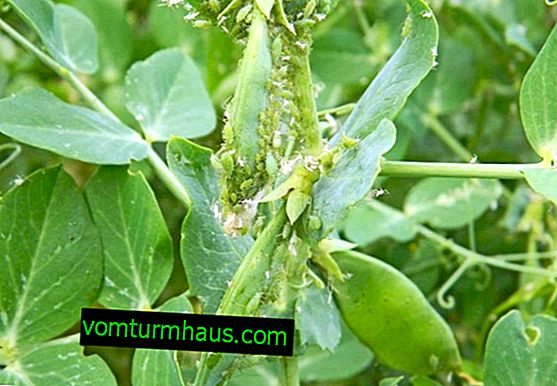
Защита от тли предполагает обязательное соблюдение агротехнических норм, а именно:
- сев раннеспелых сортов;
- регулярное опрыскивание простой водой поможет уничтожить до 50% вредителя, развитие которых в условиях повышенной влажности замедляется;
- тщательная ликвидация сорняков;
- изоляция гороха от других бобовых посевов, в которых также зимует тля;
- использование таких химических препаратов, как Искра, Фастак и Фитоверм, а ещё не менее эффективны всевозможные настои — к примеру, от тли отлично избавляет зольно-мыльный раствор;
- устранение вредителя происходит в комплексе с устранением муравьёв, которые содействуют его размножению.
Вам будет интересно, как в домашних условиях правильно засолить горох.
Для того чтобы получить хороший и богатый урожай, необходимо заблаговременно позаботиться о профилактике растений от болезней и вредителей, появления которых можно избежать, соблюдая профилактические меры и предварительную обработку народными средствами или химическими препаратами. Комплекс данных мероприятий поможет насладиться вкусным и полезным овощем и защитить огород от нашествия всевозможных напастей.












